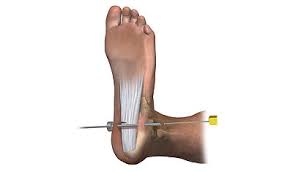Exploring Endoscopic Plantar Fasciotomy: A Minimally Invasive Solution for Plantar Fasciitis
- heelandtoepodiatry
- Sep 6, 2023
- 2 min read
Heel pain can be a debilitating condition that affects millions of people worldwide. One of the leading causes of heel pain is plantar fasciitis, a condition characterized by inflammation of the plantar fascia, a thick band of tissue that runs along the bottom of the foot. While conservative treatments like rest, physical therapy, and orthotics can provide relief for many, some cases may require a more advanced approach. Endoscopic Plantar Fasciotomy (EPF) is a cutting-edge, minimally invasive procedure that has gained popularity in recent years for its ability to provide long-term relief from plantar fasciitis. In this blog post, we will explore the key aspects of EPF, its benefits, and what patients can expect from this innovative procedure.
Understanding Plantar Fasciitis Before delving into EPF, it's essential to understand the nature of plantar fasciitis. This condition typically presents as sharp, stabbing heel pain, often worse in the morning or after prolonged periods of rest. It can be caused by factors such as overuse, improper footwear, obesity, or biomechanical issues. When conservative treatments fail to alleviate the pain, surgical options like EPF become viable alternatives.
The Endoscopic Plantar Fasciotomy Procedure
Endoscopic Plantar Fasciotomy is a minimally invasive surgical technique designed to relieve the tension and inflammation in the plantar fascia. Here's how the procedure works:
Anesthesia: Patients are typically given local anesthesia to numb the foot, ensuring they remain comfortable throughout the procedure.
Incision: A small incision, typically less than 1 cm in size, is made near the heel.
Endoscope insertion: An endoscope (a thin, flexible tube with a camera) is inserted through the incision, allowing the surgeon to visualize the plantar fascia.
Fascia release: Using specialized instruments, the surgeon cuts and releases the tight portion of the plantar fascia, relieving pressure and tension.
Closure: The incision is closed with a few sutures, and a bandage is applied.
Benefits of Endoscopic Plantar Fasciotomy
Minimally invasive: EPF is a minimally invasive procedure, resulting in smaller incisions, less scarring, and reduced recovery time compared to traditional open surgery.
Quick recovery: Many patients can bear weight on the treated foot shortly after surgery and return to normal activities within a few weeks.
High success rate: EPF has a high success rate in providing long-term relief from plantar fasciitis symptoms, with many patients reporting significant improvement in pain and function.
Reduced risk of complications: The minimally invasive nature of EPF minimizes the risk of infection and other surgical complications.
Conclusion
Endoscopic Plantar Fasciotomy is an effective and minimally invasive solution for individuals suffering from persistent plantar fasciitis. While not all patients may require surgery, EPF can offer substantial relief for those who have exhausted conservative treatments without success. If you're considering EPF, give us a call to discuss your options and determine if this procedure is the right choice for you. With its high success rate and quick recovery time, EPF may be the key to finally putting an end to your heel pain and regaining your mobility and quality of life.



Comments